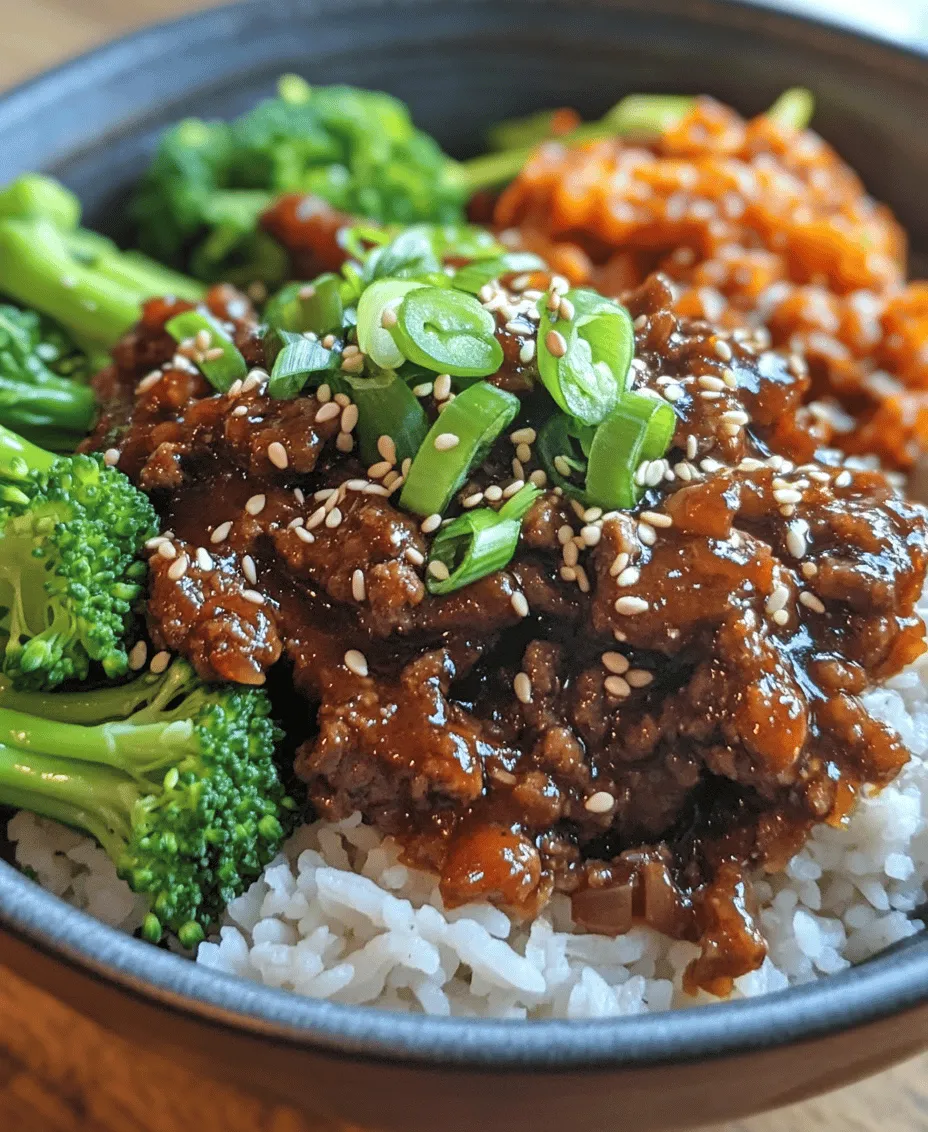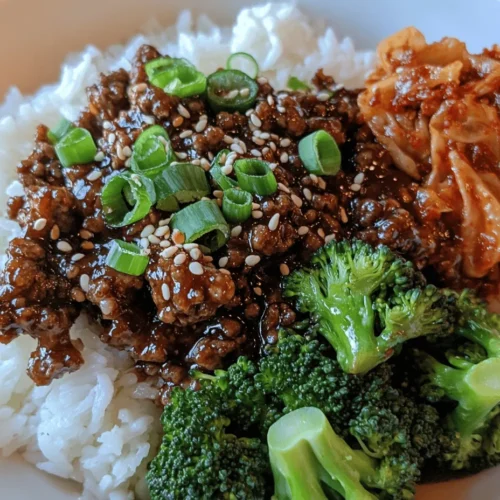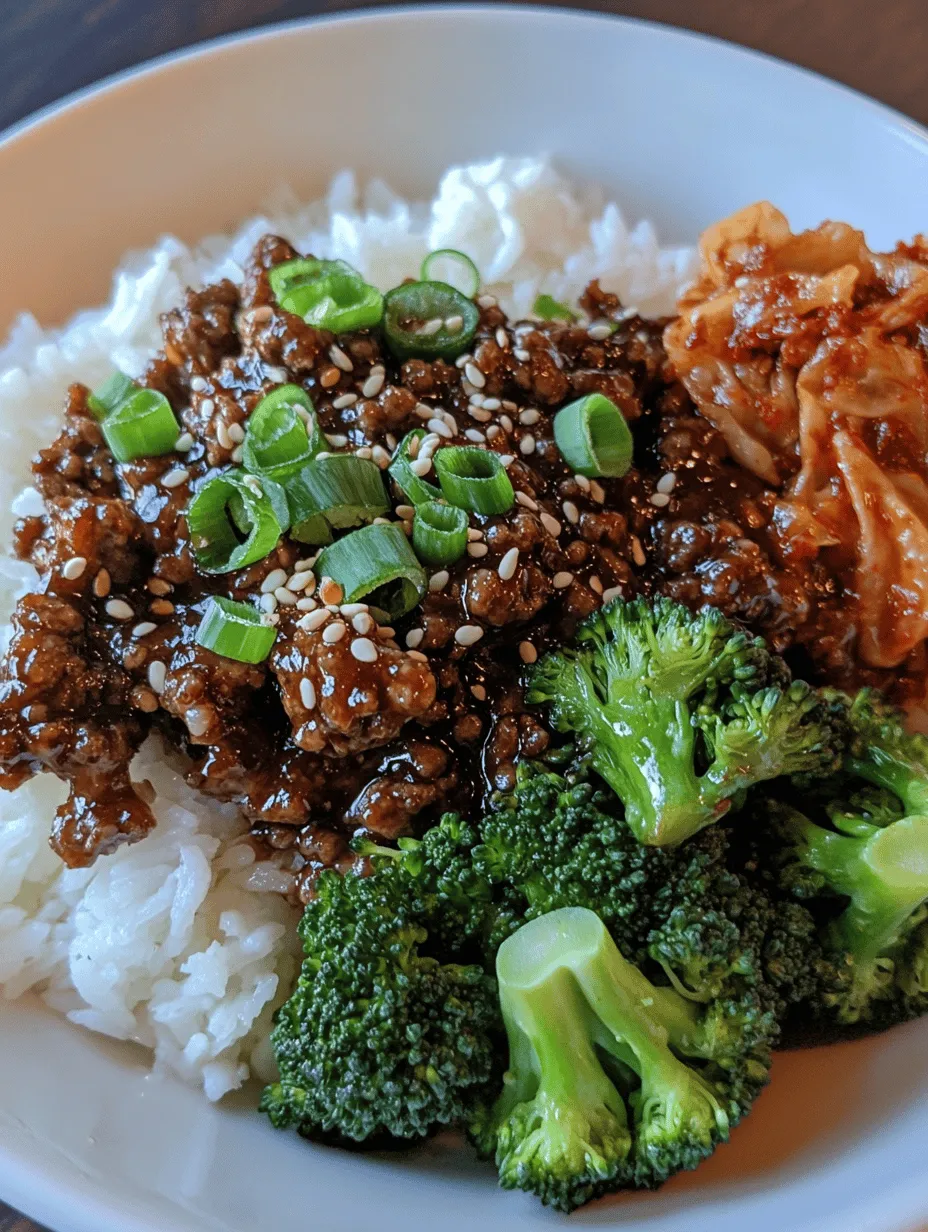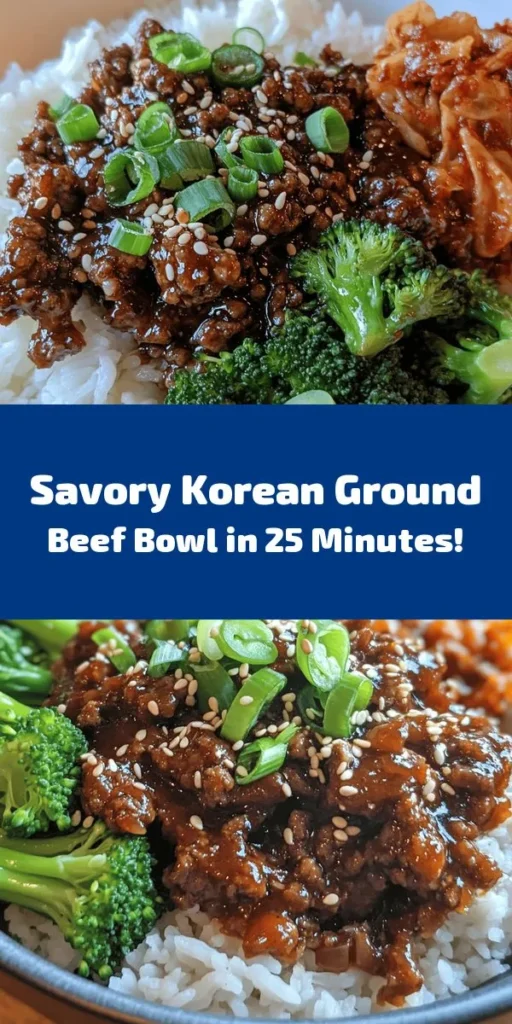Introduction
Korean cuisine has rapidly gained recognition and popularity across the globe, captivating food lovers with its unique flavors, rich traditions, and health-conscious ingredients. From the spicy kick of kimchi to the savory depth of bulgogi, Korean dishes offer a delightful array of tastes that can appeal to various palates. One such dish that has made its way into the hearts and homes of many is the Korean Ground Beef Bowl. This recipe combines the essence of Korean flavors with the practicality of a quick and nutritious meal, making it a perfect choice for busy weeknights or a satisfying lunch.
The Korean Ground Beef Bowl is not just a dish; it’s an experience that brings together the vibrant tastes of Korea in a single bowl. With its easy preparation, robust flavors, and versatility, it has become a staple in many households. Whether you’re a seasoned cook or a beginner in the kitchen, this recipe promises to deliver a delightful culinary experience that is both comforting and exciting.
In this article, we will explore the Korean Ground Beef Bowl in depth, discussing its cultural significance, nutritional benefits, and, of course, providing you with a detailed recipe that you can easily follow at home.
Understanding Korean Ground Beef Bowl
At its core, a Korean Ground Beef Bowl is a stir-fry dish that features ground beef cooked in a savory sauce made from soy sauce, brown sugar, garlic, and sesame oil, among other ingredients. The dish is typically served over rice and can be topped with fresh vegetables and garnishes, making it a colorful and balanced meal.
This bowl is a wonderful representation of Korean cuisine, which often emphasizes harmony between flavors and textures. The sweet and salty notes of the beef, combined with the freshness of vegetables and the fragrance of sesame oil, create a delightful dish that is both satisfying and nourishing.
Culturally, the Korean Ground Beef Bowl reflects the Korean tradition of communal eating, where dishes are often shared among family and friends. It embodies the spirit of togetherness and celebration that is central to Korean meals.
In terms of nutrition, this dish is a powerhouse of essential nutrients. Ground beef serves as an excellent source of protein, while the addition of broccoli and green onions provides vitamins, minerals, and dietary fiber. The use of jasmine rice as a base not only adds carbohydrates for energy but also complements the flavors of the dish beautifully.
Ingredients Breakdown
To create a flavorful and authentic Korean Ground Beef Bowl, it’s essential to choose high-quality ingredients. Let’s break down each component of the dish:
Ground Beef
Ground beef is the star of this recipe, and selecting the right type can enhance the dish’s overall flavor. For a Korean Ground Beef Bowl, lean ground beef (80/20) is recommended. This blend offers a good balance of flavor and fat, ensuring that the beef remains juicy without being overly greasy. If you’re looking for a healthier option, you can also opt for ground turkey or chicken, but keep in mind that the flavor profile will differ slightly.
Soy Sauce
Soy sauce is a fundamental ingredient in Korean cooking, imparting a deep umami flavor to dishes. For this recipe, regular soy sauce is ideal, but you can also explore variations such as low-sodium soy sauce or tamari for a gluten-free option. The type of soy sauce you choose can significantly impact the dish’s flavor, so select one that you enjoy.
Brown Sugar
Brown sugar plays a crucial role in the Korean Ground Beef Bowl by balancing the savory notes of the soy sauce. Its molasses content adds depth and a subtle sweetness that rounds out the flavors, making the dish more complex and satisfying. You can adjust the amount of brown sugar based on your taste preference, but a little goes a long way in achieving the perfect balance.
Sesame Oil
Sesame oil is a staple in Korean cuisine, known for its nutty aroma and rich flavor. It not only enhances the overall taste of the dish but also contributes to its authentic character. When cooking, it’s best to use toasted sesame oil, as it brings a more robust flavor compared to regular sesame oil. A little drizzle at the end of cooking can elevate the dish further.
Garlic and Ginger
Garlic and ginger are aromatic powerhouses that provide depth and warmth to the dish. Both ingredients are celebrated for their health benefits, including anti-inflammatory properties and digestive support. Freshly minced garlic and ginger offer the best flavor, but you can also use pre-minced versions if you’re short on time.
Gochugaru
Gochugaru, or Korean red pepper flakes, is a key ingredient that adds spice and color to the Korean Ground Beef Bowl. It has a mild heat level compared to other chili powders, making it suitable for varying spice tolerances. If you enjoy a little extra heat, you can adjust the quantity according to your preference.
Green Onions
Green onions, or scallions, contribute freshness and a pop of color to the dish. They can be used both as an ingredient in cooking and as a garnish, providing a crisp texture that complements the tender beef. The mild onion flavor enhances the overall taste without overpowering the other ingredients.
Jasmine Rice
Jasmine rice is the perfect base for the Korean Ground Beef Bowl, known for its fragrant aroma and slightly sticky texture. It absorbs the flavors of the beef and sauce beautifully, making every bite a delight. If jasmine rice isn’t available, you can substitute it with other types of rice, such as basmati or even brown rice for added nutrition.
Broccoli
Broccoli adds not only a vibrant green color but also essential nutrients to the dish. It is rich in vitamins C and K, fiber, and antioxidants, making it a healthy addition. You can prepare broccoli by steaming or sautéing it lightly before adding it to the bowl, ensuring it retains its crunchiness.
Sesame Seeds
Sesame seeds are often used as a finishing touch, adding a delightful crunch and enhancing the presentation of the dish. They are also a source of healthy fats and nutrients. Toasting the sesame seeds before sprinkling them on top can intensify their flavor.
Optional Kimchi
Kimchi, a staple in Korean cuisine, is a fermented vegetable dish that adds a tangy and spicy kick to your meal. While it is optional, including kimchi as a side or topping for your Korean Ground Beef Bowl can elevate the dish’s flavors and provide additional health benefits from probiotics.
With all these ingredients in hand, you are well on your way to creating a delicious Korean Ground Beef Bowl. Now, let’s dive into the step-by-step instructions for making this flavorful dish that is sure to impress your family and friends.
Step-by-Step Instructions
1. Prepare the Ingredients: Start by gathering all your ingredients. Chop the garlic and ginger finely, slice the green onions, and wash the broccoli florets. It’s essential to have everything ready before you start cooking, as this will make the process smoother and more enjoyable.
2. Cook the Rice: Begin by cooking your jasmine rice according to the package instructions. This usually involves rinsing the rice under cold water, adding it to a pot with the appropriate amount of water, and bringing it to a boil. Once it boils, reduce the heat to low, cover, and let it simmer until fully cooked, about 15-20 minutes.
3. Prepare the Beef Mixture: In a large skillet or wok, heat a tablespoon of sesame oil over medium-high heat. Once the oil is hot, add the ground beef. Cook, breaking it apart with a spatula, until it is browned and fully cooked. This should take about 5-7 minutes. Drain any excess fat if needed.
4. Add Aromatics: With the beef cooked, add the minced garlic and ginger to the skillet. Sauté for about 1-2 minutes until fragrant, stirring constantly to prevent burning.
5. Season the Beef: Pour in the soy sauce, brown sugar, and gochugaru. Stir well to combine all the ingredients, allowing the beef to absorb the flavors. Let the mixture simmer for an additional 3-5 minutes, allowing the sauce to thicken slightly.
6. Incorporate Broccoli: Add the broccoli florets to the skillet, stirring to combine them with the beef mixture. Cook for another 3-4 minutes until the broccoli is tender but still bright green.
7. Serve: Once everything is cooked, it’s time to assemble your Korean Ground Beef Bowl. Serve a generous scoop of jasmine rice in a bowl, topped with the beef and broccoli mixture. Garnish with sliced green onions and a sprinkle of sesame seeds. If desired, add a side of kimchi for an authentic touch.
With these steps, you can create a delicious Korean Ground Beef Bowl that is not only quick and easy but also packed with flavor and nutrition. Enjoy this delightful dish as a comforting meal any day of the week!

Preparing the Beef Mixture: Techniques for Flavor Infusion
To create a delicious Korean Ground Beef Bowl, the key starts with the beef mixture. The infusion of flavors in this dish comes from a combination of traditional Korean ingredients. Begin by mixing together ground beef and a variety of seasonings that will elevate the flavor profile. A classic mixture includes soy sauce, minced garlic, ginger, sesame oil, and brown sugar.
1. Marinating the Beef: Allow the ground beef to marinate for at least 15-30 minutes. This resting period enables the flavors to penetrate the meat, resulting in a more flavorful dish. If time permits, marinate for a couple of hours or even overnight in the refrigerator for deeper flavor infusion.
2. Incorporating Aromatics: Freshly minced garlic and ginger are essential in Korean cooking. They not only add depth but also provide a fragrant quality to the beef. Ensure these are finely minced to distribute their flavors evenly throughout the meat.
3. Balancing Sweetness and Salinity: The combination of brown sugar and soy sauce creates a perfect balance of sweet and salty. Adjust these ingredients according to your taste preferences. For a spicier kick, consider adding gochugaru (Korean red pepper flakes) or gochujang (Korean chili paste) to the mixture.
Cooking the Beef: Tips for Achieving the Perfect Texture
Once your beef mixture is ready, it’s time to cook it to achieve that perfect texture. Here are some tips for cooking the beef:
1. High Heat Cooking: Heat a non-stick skillet or wok over medium-high heat. Once hot, add the marinated ground beef. The high heat will help to sear the beef quickly, locking in moisture and flavor.
2. Breaking It Up: Use a spatula or wooden spoon to break the beef into small crumbles as it cooks. This not only helps cook the meat evenly but also ensures that each bite is flavorful.
3. Avoid Overcrowding the Pan: If you have a large batch, it’s better to cook the beef in batches. Overcrowding the pan can lead to steaming the meat instead of browning it. Cook until the beef is no longer pink, which should take about 5-7 minutes.
4. Adding Vegetables: If you desire a more substantial meal, consider adding diced vegetables like bell peppers or onions during the last few minutes of cooking. This not only adds nutrition but also enhances the overall flavor of the dish.
Seasoning to Taste: Importance of Personalization
One of the best aspects of cooking is the ability to personalize your dish. After cooking the beef, taste it and adjust the seasoning according to your preference. Here are some ways to enhance the flavor:
1. Salt and Pepper: While the marinade provides a good base of flavor, a pinch of salt and freshly cracked black pepper can elevate the taste even further.
2. Acidity: A splash of rice vinegar or a squeeze of fresh lime juice can brighten the flavors and add a refreshing tang, which balances the richness of the beef.
3. Herbs and Spices: Fresh herbs like green onions or cilantro can be mixed in at the end for an added layer of flavor. Experiment with different spices to suit your palate.
Assembling the Bowl: Presentation Tips for a Visually Appealing Dish
Once your beef is cooked and seasoned, it’s time to assemble your Korean Ground Beef Bowl. A well-presented dish can make the meal even more enjoyable. Here are some tips to enhance the visual appeal:
1. Layering: Start with a base of fluffy white rice or brown rice. Spoon the cooked ground beef mixture over the rice, ensuring an even distribution.
2. Color Contrast: Incorporate a variety of colors into your bowl. Brightly colored vegetables like shredded carrots, sliced cucumbers, and vibrant bell peppers can add visual interest and crunch.
3. Creating Height: Consider stacking your ingredients in a way that creates height. This can make the dish look more gourmet and inviting.
4. Serving in Bowls: Use shallow bowls or deep plates to serve. The shape can affect how the dish is perceived, and deeper vessels can showcase the layers beautifully.
Garnishing: Creative Ideas for Enhancing the Final Look
Garnishing your Korean Ground Beef Bowl can elevate not only the presentation but also the flavor. Here are some creative garnishing ideas:
1. Sesame Seeds: Toasted sesame seeds add a nutty flavor and a lovely crunch. Sprinkle them generously over the top for a decorative touch.
2. Sliced Green Onions: Chopped green onions contribute a fresh and mild onion flavor that complements the dish well. Scatter them on top just before serving.
3. Pickled Radishes: Adding pickled vegetables, such as radishes or cucumbers, introduces a tangy element that contrasts beautifully with the savory beef and rice.
4. Soft-Boiled Egg: A soft-boiled egg, with its creamy yolk, can be a luxurious addition. Cut it in half and place it on top of the beef mixture for a beautiful and rich finish.
Serving Suggestions
To make your Korean Ground Beef Bowl even more exciting, consider these serving suggestions:
1. Customizing the Bowl: Encourage creativity by allowing everyone to customize their bowls. Provide a variety of toppings and sauces for a personalized experience.
2. Additional Vegetables: Incorporate fresh vegetables like sliced bell peppers, shredded cabbage, or julienned carrots to add texture and flavor. These can be raw for crunch or sautéed for warmth.
3. Alternative Proteins: While ground beef is traditional, feel free to experiment with other proteins. Ground chicken, turkey, or even tofu and shrimp can serve as excellent substitutes, providing different flavors and textures.
4. Side Dishes: Enhance your meal with classic Korean side dishes such as kimchi, pickled vegetables, or a simple salad. These add variety and complement the flavors of the beef bowl.
5. Meal Prep and Storage Options: This dish is perfect for meal prep. Cook a larger batch of the ground beef mixture and store it in airtight containers in the fridge for up to four days, or freeze for longer storage. Reheat and serve with freshly cooked rice and toppings for a quick meal.
Health and Nutrition Aspect
The Korean Ground Beef Bowl is not only delicious but also offers several health benefits:
1. Nutritional Value: The main ingredients, ground beef, vegetables, and rice, provide a balanced meal. Ground beef is rich in protein and essential nutrients like iron and B vitamins, while vegetables contribute fiber, vitamins, and minerals.
2. Balanced Macros: A serving of this bowl typically includes a good balance of protein, carbohydrates, and healthy fats. Adjusting the portion sizes allows you to tailor the meal to fit different dietary needs.
3. Role of Vegetables: Adding a variety of vegetables not only enhances the flavor but also boosts the fiber content of the dish. Fiber is essential for digestive health and can help maintain satiety.
4. Dietary Adaptability: This dish can fit into various dietary lifestyles. For those following a keto diet, substitute rice with cauliflower rice. For a gluten-free option, ensure your soy sauce is gluten-free, or use tamari.
Cultural Context and Variations
Understanding the cultural background of Korean dishes can deepen your appreciation for the flavors:
1. History of Beef Bowls in Korean Cuisine: Beef bowls, or “bibimbap,” have a rich history in Korea, often served as a way to utilize leftover ingredients. The combination of rice, vegetables, and meat represents harmony in Korean culture.
2. Regional Variations: Different regions in Korea feature their variations of beef bowls, often incorporating local ingredients or unique spices. For instance, Jeonju bibimbap includes a variety of vegetables and is known for its exceptional flavor.
3. Global Influence: Korean cuisine has gained popularity worldwide, influencing global food trends. The incorporation of Korean flavors into everyday meals has become a culinary movement, making dishes like the Korean Ground Beef Bowl accessible and beloved around the globe.
Conclusion
In summary, the Korean Ground Beef Bowl is a delightful dish that combines rich flavors, nutritional benefits, and cultural heritage. From preparing the beef mixture to assembling a visually appealing bowl, every step contributes to creating a satisfying meal. The flexibility in customizing toppings and the ability to adapt the dish to various dietary preferences make it a perfect choice for any occasion.
Encouraging you to try making this dish at home allows you to experience the authentic flavors of Korea while enjoying the comfort of a hearty, satisfying meal. Dive into the world of Korean cuisine with this easy-to-follow recipe, and savor every bite of this comforting bowl of goodness. Embrace the flavors, enjoy the cooking process, and share the joy of this delicious dish with friends and family.



